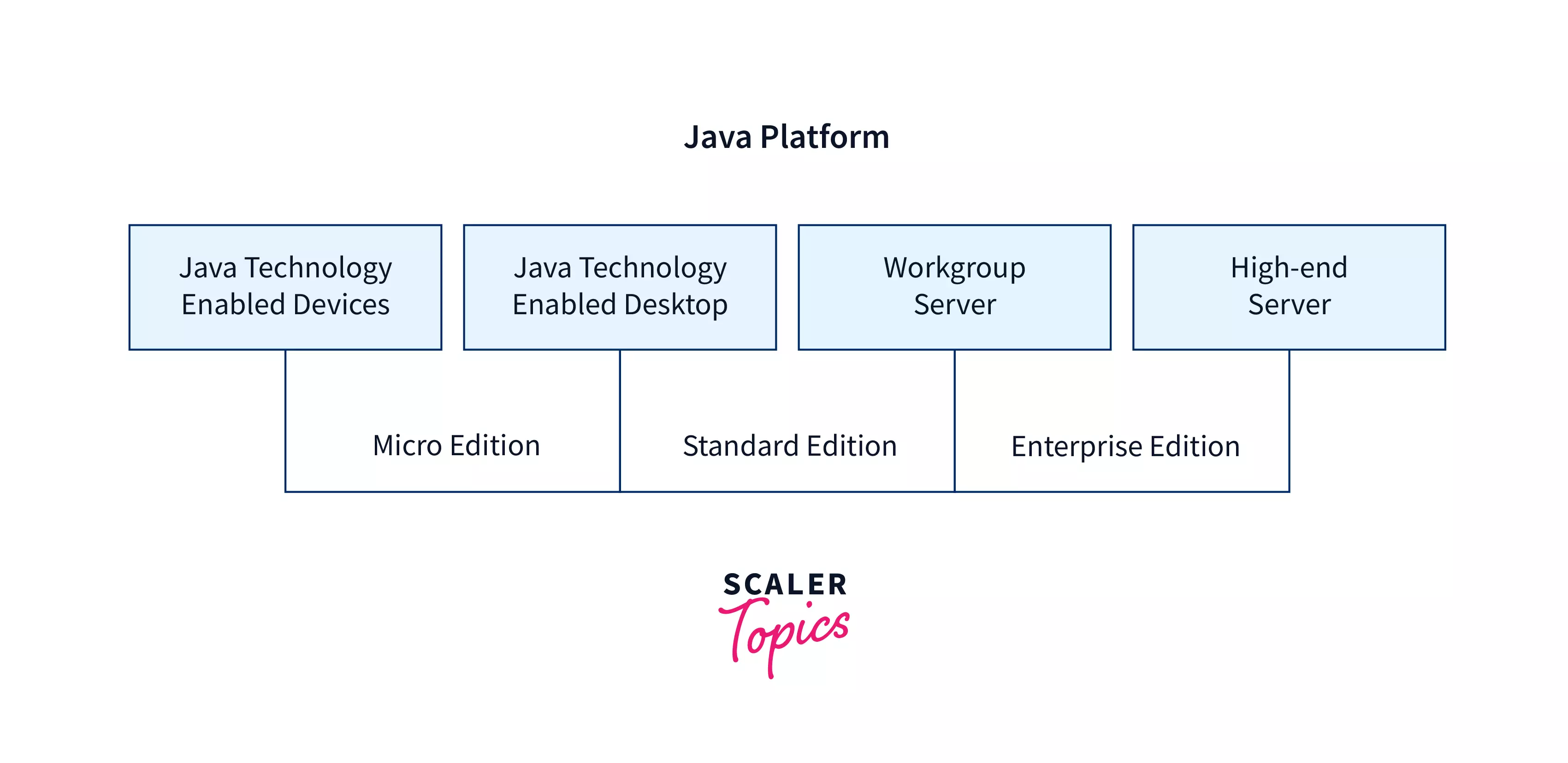Types of Java

Java technology functions as both a platform and a programming language. High-level object-oriented language Java has a specific syntax and structure. A Java platform is a specific setting where Java programming language programs can be used. Java platforms are divided into four editions, Java Standard Edition (Java SE), Java Enterprise Edition (Java EE), Java Micro Edition (Java ME), and JavaFX.
What are the Various Types of Java?
The Four Types of Java:
- Java Standard Edition (Java SE),
- Java Enterprise Edition (Java EE), and
- Java Micro Edition (Java ME).
- JavaFX
All these Java editions consist of an API (Application Programming Interface) and JVM (Java Virtual Machine). The Java Virtual Machine (JVM) tool is used to run Java programs on a certain platform. An API is used to build other software parts or programs. Each Java platform provides a virtual machine and an API to enable the programs created for that platform to run on any compatible system and take full use of the benefits of the Java programming language.

The Java Programming Language Platforms
Java Platform, Standard Edition (Java SE)
The Java Platform Standard Edition (Java SE) comprises APIs (Application Programming Interfaces) that provide Java's fundamental programming features. It specifies every aspect of the Java programming language, from its fundamental types and objects to its high-level classes for security, Graphical User Interface development, database manipulation, networking, etc.
The Java SE Platform Includes:
- JVM (Java Virtual Machine),
- JDK (Java Development Kit),
- JRE (Java Run-time Environment), and
- Various class libraries.
These components of Java SE are frequently used in Java technology applications in extension to the main APIs.
Java Platform, Enterprise Edition (Java EE)
The Java Enterprise Edition (Java EE) was developed to expand the Java SE by adding a collection of standards/specifications that describe frequently used features by commercial applications. The most recent version of this edition includes more than 40 specifications that assist programmers in building applications that use web services to exchange data, transform object-relational data into entity-relationship models, manage transactional interactions, and other things.
The most used features of Java EE are:
- Java Server Pages (JSP): It is a server-side programming language that allows constructing dynamic, device-independent ways to build web-based applications.
- Java Server Faces (JSF): The JSF API offers elements such as inputText, commandButtons, and others and assists in managing their states. Additionally, it offers data translation, server-side validation, etc.
- Java Persistence API (JPA): Java developers get access to an object/relational mapping mechanism through the Java Persistence API to manage relational data in Java applications.
- Enterprise Java Beans (EJB): EJB is one of the many Java APIs used for developing corporate applications. It is a server-side software component that defines an application's business logic.
Java Platform, Micro Edition (Java ME)
Java Micro Edition was developed to facilitate mobile and embedded device applications. This edition is not quite as popular as other editions like Java SE and Java EE, but recently, the Internet of Things (IoT) gadgets have given this technology new hope. The Java ME platform offers an API and a small-footprint virtual machine that helps run Java ME applications on compact devices.
Some examples of Java ME applications are given below:
- Calculator for Mobile, which demonstrates the functionality of multi-threading.
- GPIO (General Purpose Input Output) applications.
- Location APIs, etc.
JavaFX
JavaFX is a platform that provides a modern, hardware-accelerated graphics and media engine for building rich online and desktop applications. It uses a simple and powerful scripting language (JavaFX Script) to enable the development of rich online, GUI, and Desktop applications. JavaFX was created in Java to replace Swing as the default GUI library.
Some applications of JavaFX are given below:
- NEOS – New Eurovision Operations System used in Television media.
- Quote Monitor application is used in the field of finance.
- GEONS Ground System Software (GGSS) Nasa is used in space technology.
- FORUM Carl Zeiss Meditec AG is used in medicines.
Conclusion
- Java platforms are divided into four editions: Java Standard Edition (Java SE), Java Enterprise Edition (Java EE), Java Micro Edition (Java ME), and JavaFX.
- The Java Standard Edition (Java SE) consists of APIs that provide Java's fundamental features, such as security, networking, GUI development, etc.
- The Java Enterprise Edition (Java EE) was developed to expand the Java SE by adding a collection of specifications that describe frequently used features by commercial applications.
- The Java Micro Edition (Java ME) was developed to facilitate mobile and embedded device applications.
- The JavaFX platform uses a simple API to enable the development of rich online applications.
